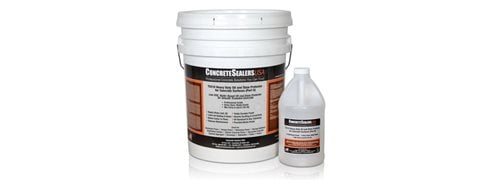- Concrete Sealer
- Comparison Chart of Concrete Sealers
- Buying Tips for Concrete Sealer Products
- Concrete Sealer Reviews: Sealer products other contractors use and recommend
- Common Questions about Concrete Sealers
- How to Remove Concrete Sealer
- Types of Sealers
- Acrylic Sealers
- Epoxy Sealers
- Penetrating Sealers
- Polyurethane Sealers
- Polyaspartic Sealers
- Application Surface
- Driveway Sealer
- Patio Sealer
- Pool Deck Sealer
- Sealers for Stamped Concrete
- Concrete Floor Sealers
- Concrete Countertop Sealers
- Pool Deck Sealer
- Exposed Aggregate Sealer
Choosing the Best Sealer Application Tool
How to choose between a sprayer or roller for your sealer (SEALER SERIES Part 8)How a sealer is applied can affect the final outcome and performance as much as all the environmental factors discussed in this series combined. Using the right tools is critical to achieving the best coverage rate and sealer thickness for optimal performance. While there are some general rules or guidelines for applying sealer, you should always refer to the manufacturer's installation instructions to see what they recommend.
The most important rule to remember is that less is more. You should apply sealer in multiple thin coats vs. one thick heavy coat. To get this liquid sealer down on the surface in the most efficient manner—and give it the best chance to harden and not fail—you need to ask yourself the following questions:
- Is the sealer solvent- or water-based? The liquid component of the sealer will determine how fast it evaporates.
- What is the solids content (usually stated in percent solids)?
- What is the resin type—acrylic, polyurethane, epoxy?
The answers to these questions will help you choose the applicator type best suited for the product you are using.
LPHV (low-pressure, high-volume) or airless sprayers: These sprayers are usually the best way to apply any sealer. They permit very controlled application rates, allowing large areas to be sealed in the shortest time. They will also handle both water- and solvent-based sealers, high and low solids contents, and any type of resin. The downside is the cost, since this spray equipment can be expensive. You may want to consider renting.
Pump-up or low-pressure sprayers: These are best for applying one-part, solvent-based sealers with a solids content below 35%. Make sure to use a sprayer that can handle solvents, and clean out the sprayer with clean solvent to avoid clogging the lines.
Roller: A paint-type roller with a 1/4- to 3/8-inch nap can be used to apply both water- and solvent-based sealers. However, when the solids content is high (above 35%), rolling becomes a problem for solvent-based sealers. Rough surfaces and high temperatures can also present problems when rolling solvent-based sealers due to puddling and surface bubbling. Consider spraying followed back rolling when sealing stamped or textured surfaces with a solvent-based sealer.
Lamb's wool applicator: This is basically a wool rag wrapped around a wooden block. It's great for applying high-solids (above 35%) solvent-based sealers, especially polyurethanes and epoxies. But its use is limited to smooth surfaces because the applicator will not run over a rough surface.
T-bar: A metal straight edge used to pull very high-solids-content (35% +) polyurethane and epoxy sealers across smooth surfaces.
Micro-fiber applicator: This synthetic-fiber pad (Padco Floor Coaters) is best for applying water-based low-solids sealers on smooth surfaces and is a great way to achieve very thin coverage. Push and pull the sealer around, maintaining a wet edge.
Synthetic closed-loop mop: Use this applicator for water-based finish sealers (waxes) only. Move the finish around with the mop, maintaining a wet edge.
Author Chris Sullivan, ConcreteNetwork.com technical expert and vice president of sales and marketing for ChemSystems Inc.
Return to How to Fix Concrete Sealing Issues
 D-One Penetrating Sealer
Non-yellowing, low sheen, good adhesion
D-One Penetrating Sealer
Non-yellowing, low sheen, good adhesion
 Deep Penetrating Sealer
RadonSeal - Waterproofs & strengthens.
Deep Penetrating Sealer
RadonSeal - Waterproofs & strengthens.
 Clear-Seal by Increte Systems
Seals and protects decorative surfaces.
Clear-Seal by Increte Systems
Seals and protects decorative surfaces.
 Heavy Duty Oil & Stain Protector
TS210 - 4 gal. kit ($439.95)
Heavy Duty Oil & Stain Protector
TS210 - 4 gal. kit ($439.95)
 Gem-Guard SB
Penetrating sealer that protects against salt damage
Gem-Guard SB
Penetrating sealer that protects against salt damage
 Decorative Sealers
Reactive and penetrating formulas in various levels of gloss.
Decorative Sealers
Reactive and penetrating formulas in various levels of gloss.
 Water Repellent Penetrating
Sealer for driveways, parking structures, plazas, walkways & more.
Water Repellent Penetrating
Sealer for driveways, parking structures, plazas, walkways & more.
 Clear Acrylic Concrete Sealer
$219.30 (5 gal.)
Clear Acrylic Concrete Sealer
$219.30 (5 gal.)
 Colored Concrete Sealer X-4
High gloss finish available in 20 colors
Colored Concrete Sealer X-4
High gloss finish available in 20 colors




